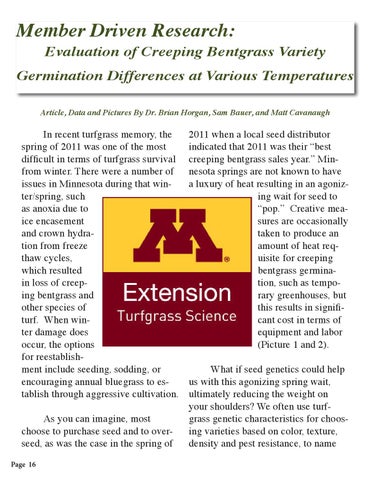Member Driven Research:
Evaluation of Creeping Bentgrass Variety
Germination Differences at Various Temperatures Article, Data and Pictures By Dr. Brian Horgan, Sam Bauer, and Matt Cavanaugh
In recent turfgrass memory, the spring of 2011 was one of the most difficult in terms of turfgrass survival from winter. There were a number of issues in Minnesota during that winter/spring, such as anoxia due to ice encasement and crown hydration from freeze thaw cycles, which resulted in loss of creeping bentgrass and other species of turf. When winter damage does occur, the options for reestablishment include seeding, sodding, or encouraging annual bluegrass to establish through aggressive cultivation. As you can imagine, most choose to purchase seed and to overseed, as was the case in the spring of Page 16
2011 when a local seed distributor indicated that 2011 was their “best creeping bentgrass sales year.” Minnesota springs are not known to have a luxury of heat resulting in an agonizing wait for seed to “pop.” Creative measures are occasionally taken to produce an amount of heat requisite for creeping bentgrass germination, such as temporary greenhouses, but this results in significant cost in terms of equipment and labor (Picture 1 and 2). What if seed genetics could help us with this agonizing spring wait, ultimately reducing the weight on your shoulders? We often use turfgrass genetic characteristics for choosing varieties based on color, texture, density and pest resistance, to name
